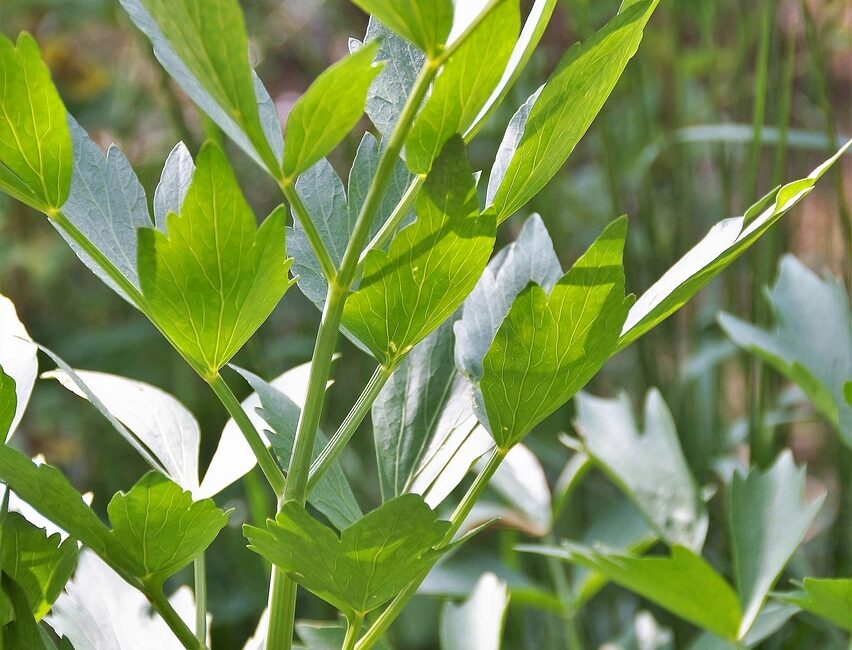Lovage, a herb that has slipped through the cracks of contemporary culinary fame, is slowly making its way back into kitchens and gardens. This tall, robust plant, with its celery-like appearance and distinctive flavor, is worth rediscovering for its unique ability to enhance a wide range of home chef meals. But what exactly does lovage taste like, and how can it be used to elevate your cooking? Let’s delve into the flavor profile of this forgotten herb and explore its culinary potential. Just like what we did with Fennel.
The Flavour Profile of Lovage
Lovage (Levisticum officinale) boasts a complex and potent flavour that can be best described as a mix of celery, parsley, and a hint of anise or fennel. Its taste is bold and assertive, with a deep, earthy undertone that adds a rich layer to any dish. The leaves, seeds, and roots of lovage each have their own distinct nuances:
- Leaves: The leaves are the most commonly used part of the plant. They have a strong celery-like flavor, with a slightly bitter edge and a hint of sweetness. Some people detect subtle notes of lemon and pepper.
- Seeds: Lovage seeds are often compared to fennel or caraway seeds, possessing a warm, slightly spicy taste with an anise-like sweetness.
- Roots: The roots are less frequently used but have a flavor reminiscent of a more intense celery root or celeriac, with an earthy, nutty quality.
Culinary Uses of Lovage in Home Chef Meals
Given its robust flavor, a little lovage goes a long way. It can be used in various culinary applications, from salads to soups, stews, and even beverages. Here are some creative ways to incorporate lovage into your home chef meals:
- Soups and Stews: Lovage leaves and stems can add depth and complexity to soups and stews. They work particularly well in broths, chicken soup, and hearty vegetable stews.
- Salads: Finely chopped lovage leaves can be a fantastic addition to salads, providing a unique flavor boost. They pair well with other fresh herbs like parsley, dill, and chives.
- Pesto: Lovage can be used as a substitute for basil in pesto. Its strong flavor pairs well with garlic, nuts, and Parmesan cheese, creating a bold and flavorful sauce for pasta or sandwiches.
- Seasoning: Dried lovage seeds can be ground and used as a seasoning for meats, fish, and vegetables. They add a warm, slightly spicy note to dishes.
- Herbal Butter: Blend chopped lovage leaves with softened butter, lemon zest, and a touch of salt to create a flavorful herb butter. This can be used to enhance the taste of grilled meats, roasted vegetables, or simply spread on fresh bread.
- Infusions: Lovage leaves can be used to infuse oils, vinegars, and even spirits like vodka or gin. These infusions capture the herb’s unique flavor, adding a sophisticated twist to dressings, marinades, and cocktails.
Lovage in Traditional and Modern Cuisine
Lovage has a rich history in traditional European cuisine, particularly in French, German, and Eastern European cooking. It was commonly used in medieval times, both as a culinary herb and for its purported medicinal properties. Today, lovage is experiencing a revival among chefs and home cooks who appreciate its distinctive flavor and versatility.
In modern cuisine, lovage is often used to add an unexpected twist to familiar dishes. Its strong, celery-like taste can enhance the flavor profile of contemporary recipes, making it a favorite among those looking to experiment with new ingredients in their home chef meals.
Growing and Harvesting Lovage
If you’re intrigued by lovage and want to try it fresh, consider growing it in your garden. Lovage is a perennial herb that thrives in well-drained soil and full sun to partial shade. It can grow quite tall, reaching up to six feet, so make sure to give it plenty of space.
Harvest the leaves when they are young and tender for the best flavor. The seeds can be collected once the plant flowers and the seed heads turn brown. The roots can be dug up in the fall or early spring.
Lunchtime Recipe for Home Chef Meals: Lovage and Potato Soup
Here’s a simple yet delicious recipe to get you started with lovage in your home chef meals:
Lovage and Potato Soup
Ingredients:
- 2 tablespoons olive oil
- 1 medium onion, chopped
- 2 cloves garlic, minced
- 4 medium potatoes, peeled and diced
- 4 cups vegetable or chicken broth
- 1 cup fresh lovage leaves, chopped
- Salt and pepper to taste
- 1/2 cup heavy cream (optional)
- Fresh lovage leaves for garnish
Instructions:
- Sauté the Aromatics: In a large pot, heat the olive oil over medium heat. Add the chopped onion and garlic, and sauté until they are soft and translucent, about 5 minutes.
- Add Potatoes and Broth: Add the diced potatoes to the pot and pour in the broth. Bring the mixture to a boil, then reduce the heat and let it simmer until the potatoes are tender, about 15-20 minutes.
- Add Lovage: Stir in the chopped lovage leaves and continue to simmer for another 5 minutes.
- Blend the Soup: Use an immersion blender to purée the soup until smooth. If you prefer a chunkier texture, you can blend only half of the soup or use a potato masher.
- Season and Add Cream: Season the soup with salt and pepper to taste. If desired, stir in the heavy cream for a richer texture.
- Serve: Ladle the soup into bowls and garnish with fresh lovage leaves. Serve hot with crusty bread.
This Lovage and Potato Soup is a perfect example of how lovage can elevate a simple dish, transforming it into a flavorful and satisfying meal. Enjoy this herb-infused soup for a comforting lunch that showcases the unique taste of lovage in your home chef meals.
FAQ about Lovage and Home Chef Meals
1. What dishes can lovage be used in? Lovage can be used in soups, stews, salads, pesto, seasoning, herbal butter, and infusions. Its bold, celery-like flavor enhances a variety of dishes.
2. How does lovage compare to celery? Lovage has a stronger, more intense flavor than celery, with additional notes of parsley and anise. It can be used as a substitute for celery in many recipes but in smaller quantities.
3. Can I grow lovage at home? Yes, lovage is a perennial herb that is relatively easy to grow. It thrives in well-drained soil and full sun to partial shade and can grow up to six feet tall.
4. How should I store lovage? Fresh lovage leaves can be stored in the refrigerator for up to a week. For long-term storage, you can dry the leaves and seeds or freeze the leaves.
5. Are there any health benefits to eating lovage? Lovage has been traditionally used for its medicinal properties, including digestive support and anti-inflammatory benefits. However, it should be consumed in moderation due to its strong flavor.
6. Can I use lovage in beverages? Yes, lovage can be used to infuse oils, vinegars, and spirits like vodka or gin, adding a sophisticated twist to cocktails and dressings.



